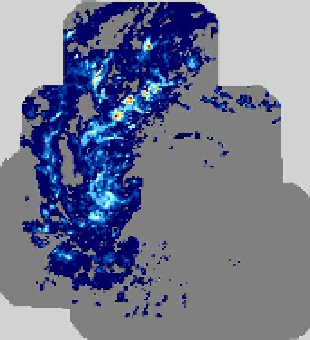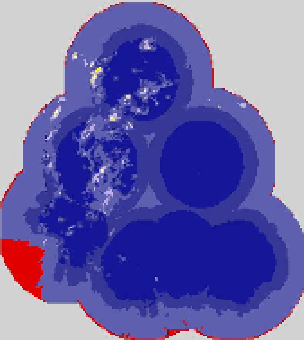Geoscience Reference
In-Depth Information
Fig. 3. Example of corrected field of precipitation rate (on the left) (composite from 5 August
2006, 03 UTC, when 7 from 8 weather radars were running) and resulting averaged quality
index
QI
(on the right) (Szturc et. al., 2011).
The final quality index
QI
field depends on all quality factors included in the scheme. The
most significant ones are height of the lowest radar beam, especially for places at longer
distances to the nearest radar site and in mountainous areas (the zero-quality area south-
west of the right map), and precipitation field variability (calculated analogically to the
related 3-D algorithm) that follows the pattern of the precipitation field to some degree. It is
noticeable that some quality factors are related to the precipitation field, whereas other fields
are static if the set of running radars is constant, as they depend on radar locations only.
6. Conclusions
Weather radar data before being applied by the end-users must be quality controlled at all
data processing stages. The main stages are generation of 3-D data (volumes) and then
specialized 2-D data (products) dedicated to certain groups of the end-users. At first, the 3-D
data should be corrected as they constitute the information source for generation of radar
products. The corrections that are related to specific products should be made at the next
stage - 2-D data processing. Due to numerous radar errors various correction techniques
must be employed, moreover radar hardware limitations determine application of particular
corrections. First of all dual-polarization radars, which will be a standard in the near future,
open up new possibilities.
In quality control of radar data apart from the data correction, information about the data
uncertainty plays also a key role. The high importance of radar data quality characterization
is appreciated not only by radar people (meteorologists, hydrologists, etc.) but by end-user
communities as well. Dealing with such quality information is a difficult task, however it is
crucial for risk management and decision-making support.
For these reasons the quality control of radar data is becoming an essential task in weather
radar data generation and processing. It has been a main subject of many international
programmes, especially: the COST Action 731 (“Propagation of uncertainty in advanced
meteo-hydrological forecast systems”, 2005-2010), the EUMETNET OPERA (“Operational
Programme for the Exchange of Weather Radar Information”, from 1999), the BALTRAD





